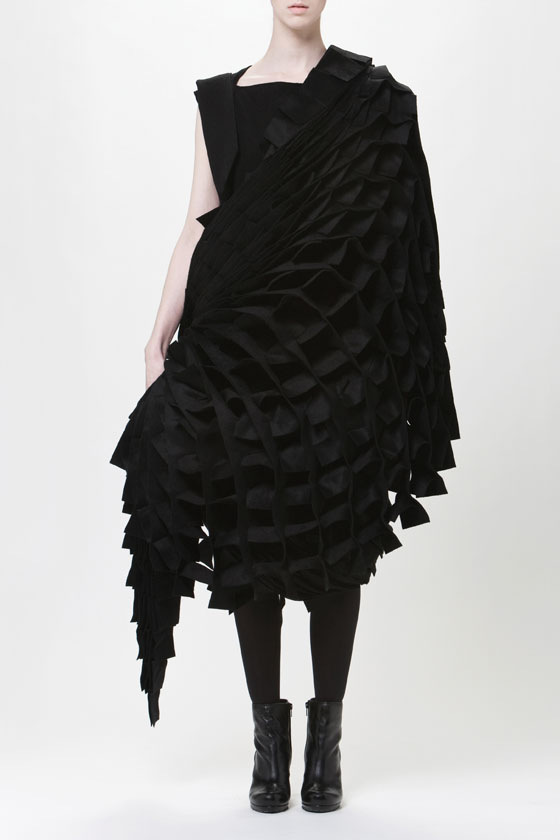
Geography, urbanism, distances and the shape of cities – unusual elements to be found in fashion, they form the basis for the work of Chinese-born, Montreal-based designer Ying Gao.
But Ying Gao is not just a designer – she is a researcher, an interactive developer of ideas, and, more formally, a professor at the Ecole superieure de mode at Montreal’s Université du Quebec.
Growing up in China and Switzerland – she is an alumna of Geneva’s Ecole des Arts Décoratifs – heightened Ying’s perception of space and urban structures. She combines this awareness with her immense knowledge of creative studies, the techniques of fashion design, and the influences of digital media. Her influences would seem to take her very far from fashion, yet she manages to incorporate them seamlessly in her work, with beautifully balanced results.
Her current collection, called “Post-Vernissage,” was created in collaboration with fashion and furniture designer Karl Latraverse, and is a perfect combination of utilitarian simplicity with remarkable structural elements. The small capsule collection, mostly comprised of limited edition or one-off pieces uses a very ascetic palette of black, anthracite gray and brown, with some garments made of white, near-transparent organza. This simplicity makes each detail stand out, and allows the structure to be the focus of the collection. Materials range from cashmere to felted wool, coated cotton and angora, engineered to create the geometric patterns that are then applied to simple tunics, or simply draped and reshaped. The motto of the collection: “We should own less, but better-designed pieces.”
“Slow wear, utopian societies, mimicry in the fashion world, photographic representation of objects and public spaces…” Ying’s previous and current projects are developed to make the viewer and the wearer think and become part of what they wear. Her glass handbag, realized in 2010 in collaboration with designer Michèle Lapointe, is a heavy, transparent bag that encases a 10-gram organza shirt. Through Gao and Lapointe’s bag, we see Gao’s mind at work: an exploration of glassmaking and textile techniques, the public and the private, the accessory and the aesthetic.
Gao recently unveiled two new projects, “Berlin–Nagoya” and “Playtime,” both of which are focused on the interaction between clothing and how it engages with its environment.
The barely-there pieces of “Berlin-Nagoya,” a scarf and a dress, double as a dress and a bag, that can also be made into a screen for projection. The project was part of The Phyllis Lambert Design Montreal Grant, which rewards projects focused on urban themes of UNESCO-Designated Cities of Design. Gao won the grant in 2008.
“Playtime,” on the other hand, is a less utilitarian-minded project. Gao constructed two dresses inspired by French director Jacques Tati’s eponymous film. A true appreciation of the project requires viewing in person, or at least on video–the materials of each dress visibly reacting to changes in light and airflow, respectively. Thus Gao explores the concept of transformation, looking at fashion in a critical, architectural, and playful way.
Both projects are incredibly contemporary, make a profound aesthetic impact, and require the technical skill of a true master to execute. In this way Gao has become similar to a modern day couturier. Such is her impact on modern arts that the Musée National des Beaux-arts du Québec is showing a retrospective of Gao’s textile research, presenting some of her most groundbreaking interactive pieces. The opportunity to interact with these pieces, as they in turn interact with their environment, is not to be missed.
– Rose Maria Bertoli

